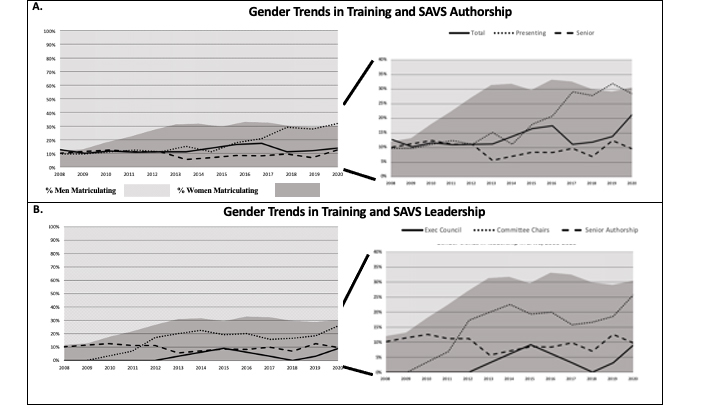15-Year Trends in Participation of Women in Presentation and Leadership Positions in the Southern Association for Vascular Surgery, 2006-2020
M. Libby Weaver1, Rebecca A. Sorber2, Michol A. Cooper1
1University of Florida, Gainesville, FL, 2Johns Hopkins University, Baltimore, MD
Background: The implementation of integrated vascular surgery training programs was recently shown to be associated with an increase in women entering the field. However, whether this has precipitated a subsequent increase in the active participation and inclusion of women in academic vascular societies remains unclear. We sought to examine the trends of academic inclusion of women vascular surgeons and surgical trainees over the past fifteen years at the Southern Association for Vascular Surgery (SAVS).Methods: Scientific programs for annual meetings of the SAVS were reviewed for the period 2006-2020. Author lists for scientific abstracts were reviewed to identify the number of women authors on each abstract, as well as their position in the author list. Publicly available data from the ACGME Data Resource Book were utilized to evaluate gender-based trends in matriculation into integrated vascular (VSIR) and vascular fellowship (VSF) programs from 2008-2019. Descriptive statistics were utilized to calculate yearly rates and three-year averages of conference participation and training program matriculation rates; Pearsonís correlation testing was used to compare trends, with ρ>0.600 defined as a strong correlation. Results: Examining 3 year means, the average number of women authors per SAVS abstract increased from 0.75 to 1.43 over the course of the study period (p<0.001) and the overall rate of women authors steadily increased from 12.6% to 21.5% (p<0.001). While this remains less than the proportion of women matriculating into vascular surgery programs in 2019 (29.3%, p=0.007), the upward trend of women entering vascular surgery overall and particularly VSF strongly correlates with the average number of women authors on abstracts at SAVS (ρ=0.709 and 0.716, respectively). The percentage of women presenting authors increased from 9.7% to 28.4% (p=0.004), but there was no increase in the percentage of women senior authors (10.1% to 9.6%, p=0.92). The number of all-men author abstracts decreased from 45.8% to 17.6% (p<0.001). In the 15 year period examined, only one abstract out of 347 (0.3%) had full authorship by women versus 35.1% with full authorship by men (p< 0.001). Although the increase of women matriculating into vascular surgery programs did not correlate with the increase of women in leadership positions (ρ=0.500), there was an increase in the number of women in committee chair positions (0.0% to 25.9%, p=0.005). Additionally, there was an increase in women holding executive council positions from 0% to 9.1% (p=0.08), although this was not statistically significant.Conclusion: Participation of women authoring and presenting papers at the SAVS has increased over the past 15 years. This upward trend of women authorship strongly correlates with the increasing rate of women entering vascular surgery training programs. As the number of women going into the field of vascular surgery continues to increase over time, it is important that SAVS leadership opportunities continue to parallel this trend as we seek to further improve diversity in vascular surgery.
Back to 2021 Abstracts

